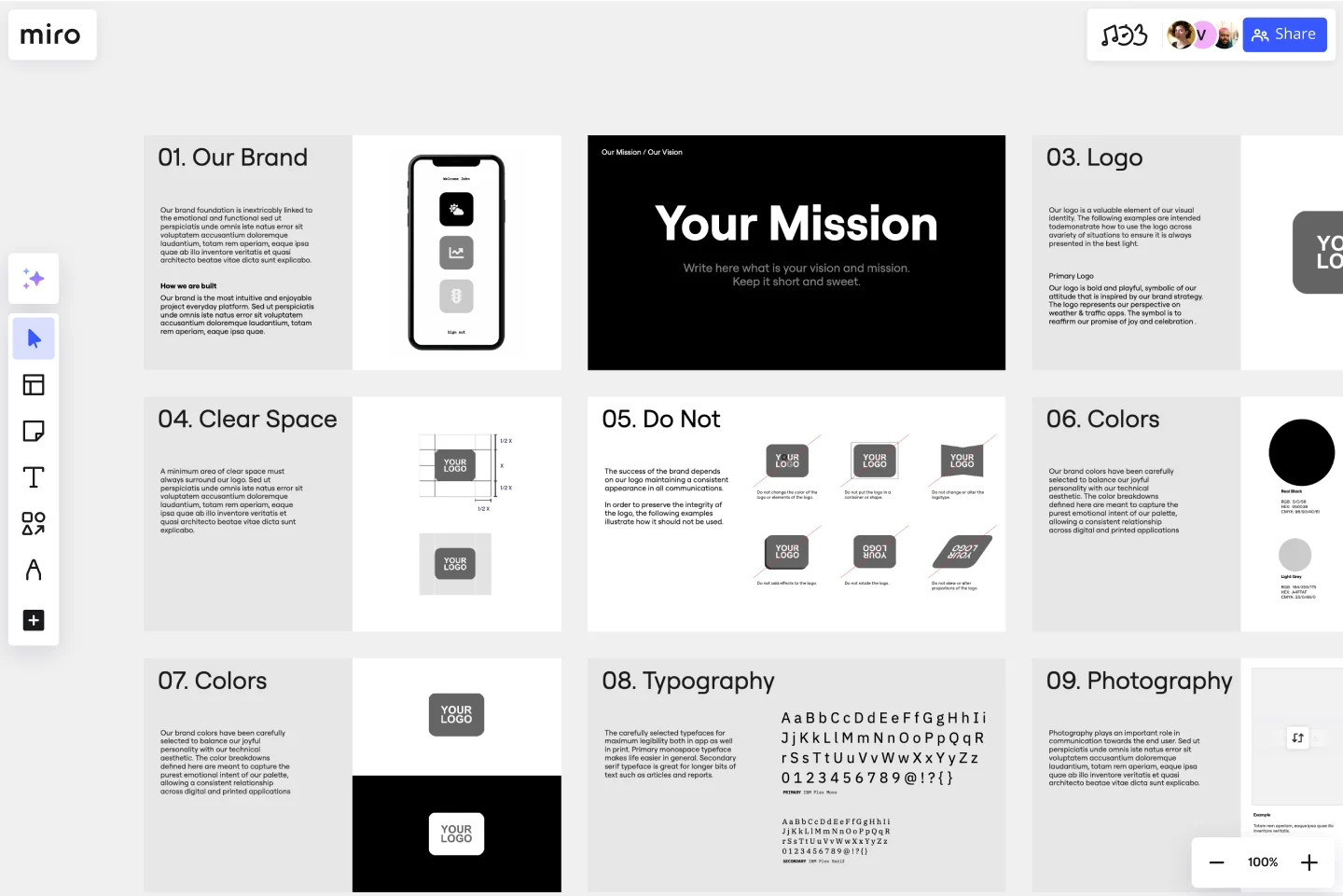Brand Guidelines Template
Identify and communicate your brand’s unique visual style and personality.
About the Brand Guidelines Template
When you think of your favorite companies, what do they have in common? For most of us, our favorite companies are defined by winning brands. The best brands are unique and instantly recognizable. They have a clear voice that informs the look and feel of their website, products, and services, marketing copy, and even how problems are solved. But brands don’t appear out of thin air.
Every great brand starts with documenting its unique brand guidelines to ensure consistency across the entire organization. These guidelines help flesh out the components that give your business its unique character. Brand guidelines should be flexible so your designers can have room to play but rigid enough to make your brand easily recognizable. That's where Miro's brand guidelines template comes in handy.
When to use the brand guidelines template
There’s never a wrong time to figure out your brand guidelines. For new businesses, brand guidelines are crucial to ensure consistency, establish trust, and foster brand recognition.
But not only new businesses can benefit from established brand guidelines. Treat them like a living document, and revisit your brand guidelines any time your brand needs refreshing: when you’re pushing into a new market, rebranding the organization, growing your business, or pivoting your product offerings.
Create your own brand guidelines
Making your own brand guidelines is easy using our simple template. Get started by selecting the brand guidelines template, then take the following steps to make one of your own.
Articulate your brand story and positioning statements. Your brand story is the narrative stream that runs through all of your marketing materials. It helps your customers connect with your brand by taking them through a journey: how you got here, what problem your brand is solving, what motivates you, and what you hope to achieve.
Connect with your customers. Customers respond to brands on an emotional level. What emotions do you want your customers to feel when they interact with your brand? Does your brand inspire loyalty? Creativity? Excitement?
Study your competitors. What do their brands look like? Dig into their voice and tone; how they present their brand; and what their products, services, websites, and marketing materials look like. Your goal here isn’t to copy competitors but to keep in mind that potential customers will be consistently comparing you to similar businesses and seeing how you measure up.
Define your brand personality. Think of your brand as a person. What are they like? How would you describe them to your friends? This brand personality will permeate everything you create. Once you nail it down, you can choose colors, fonts, photos, or other visual elements that align with your personality. Miro makes it easy to collaborate on your brand’s visual characteristics. Share graphics, talk through ideas, and iterate as a team.
Get started with this template right now.
OODA Loop Template
Works best for:
Strategic Planning, Strategy
The OODA Loop template helps optimize decision-making processes by using four key stages- Observe, Orient, Decide, and Act. Its well-structured layout allows teams to systematically break down complex decisions, leading to a shared understanding of the decision-making workflow. One of the key benefits of the template is its ability to enhance collaboration. Teams can seamlessly contribute to and iterate upon the decision-making cycle in real time, resulting in more informed decisions and a more efficient process. The template provides a clear and visual representation of each stage, accelerating the decision-making process and fostering a collaborative environment where teams can work together to navigate challenges and make well-informed decisions.
Presentation Template
Works best for:
Presentations, Education
At some point during your career, you’ll probably have to give a presentation. Presentations typically involve speaking alongside an accompanying slide deck that contains visuals, texts, and graphics to illustrate your topic. Take the stress out of presentation planning by using this presentation template to easily create effective, visually appealing slides. The presentation template can take the pressure off by helping your audience stay focused and engaged. Using simple tools, customize a slide deck, share slides with your team, get feedback, and collaborate.
Lean Canvas Template
Works best for:
Agile Methodology, Strategic Planning, Agile Workflows
Business opportunities can get dense, cumbersome, and complex, and evaluating them can be a real challenge. Let a lean canvas streamline things and break down your business idea for you and your team. A great tool or entrepreneurs and emerging businesses, this one-page business model gives you an easy, high-level view of your idea — so you can stay focused on overall strategy, identify potential threats and opportunities, and brainstorm the various factors at play in determining your potential profitability in an industry.
English Grammar Timeline Builder
The English Grammar Timeline template helps you map out the progression of grammar concepts over time. This is a great tool for educators and students to visualize the sequence and relationship between different grammar topics, making learning and teaching more effective.
Value Proposition Template
Works best for:
Strategy & Planning, Product Strategy
The Value Proposition Template is a framework that empowers businesses to articulate their offerings' core advantages. By breaking down an offering into its essential elements, this template ensures that stakeholders grasp the unique value a product or service brings to the market.
Bang for the Buck Template
Works best for:
Project Management, Strategic Planning, Prioritization
The name pretty much says it—this Agile framework is all about helping you maximize efficiency by powering collaboration between product managers and dev teams. Together you can go over each to-do on the project agenda and evaluate them in terms of costs and benefits. That way you can prioritize tasks based on how much bang for your buck they deliver. This template is great for teams and organizations that want to make a strategic plan to tackle an upcoming sprint.
